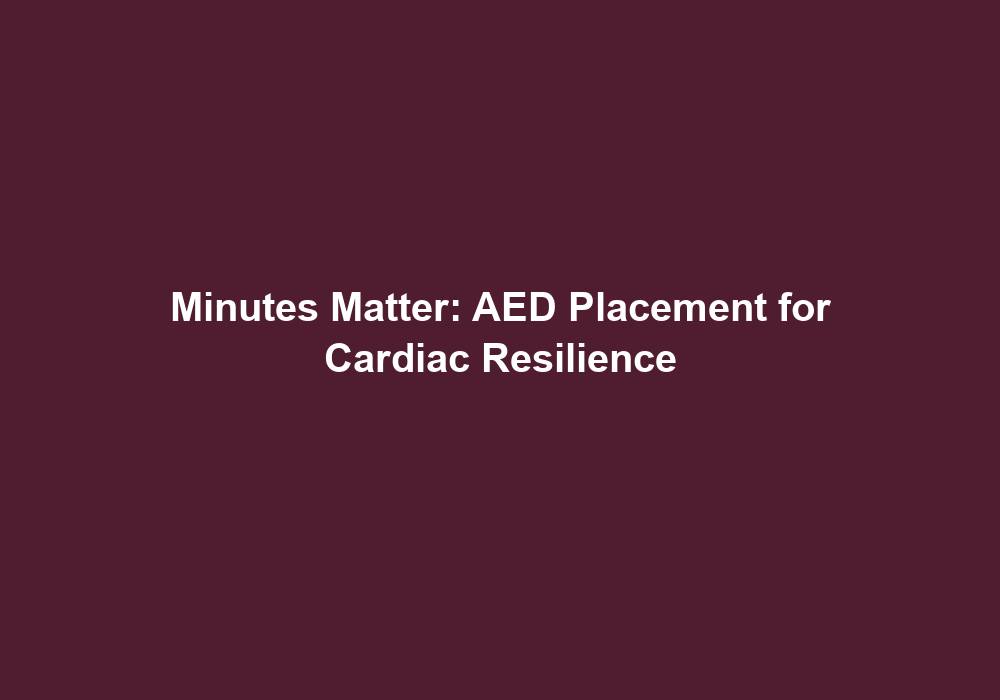Minutes Matter: AED Placement for Cardiac Resilience
Cardiac emergencies can occur at any time and in any place. When someone experiences a sudden cardiac arrest, every second counts in providing them with life-saving assistance. That is why the placement of Automated External Defibrillators (AEDs) in strategic locations is crucial for ensuring cardiac resilience within communities. In this article, we will explore the importance of AED placement, the factors to consider when determining their locations, and how they can significantly improve the chances of survival for individuals facing cardiac emergencies.
The Significance of AED Placement
An Automated External Defibrillator (AED) is a portable device that delivers an electric shock to the heart to help restore its normal rhythm during a sudden cardiac arrest. These devices are designed to be used by individuals with minimal medical training, making them accessible to bystanders who can provide immediate assistance before professional medical help arrives. The strategic placement of AEDs in various locations can greatly reduce response times and increase the chances of survival for cardiac arrest victims.
Importance of AED Placement in High-Traffic Areas
Placing AEDs in areas where a large number of people gather, such as airports, shopping malls, sports stadiums, and public transportation hubs, is crucial. These locations have a higher likelihood of witnessing a cardiac emergency due to the larger population present. By having AEDs readily available in these high-traffic areas, the response time can be significantly reduced, increasing the chances of immediate defibrillation and successful resuscitation.
Some key points to consider when placing AEDs in high-traffic areas include:
- Identifying the busiest areas within the location where people tend to congregate.
- Ensuring AEDs are easily visible and accessible, with clear signage directing individuals to their location.
- Regularly checking and maintaining the AEDs to ensure they are in working condition.
Proximity to Health Facilities for Quick Access
Placing AEDs near hospitals, clinics, and medical offices can help ensure that medical professionals can quickly access these devices in case of emergencies. This proximity allows for easy maintenance and periodic checks to ensure the AEDs are functioning properly. In addition, having AEDs close to health facilities enables collaboration between medical professionals and bystanders, as they can work together to provide the best possible care to cardiac arrest victims.
Key considerations for AED placement near health facilities include:
- Identifying the optimal locations within the facility where AEDs can be easily accessed during emergencies.
- Training staff members on the proper use and maintenance of AEDs.
- Establishing a system for regular checks and maintenance of AEDs to ensure their effectiveness.
AED Placement in Educational Institutions
Schools, colleges, and universities should have AEDs readily available. Sudden cardiac arrests can occur in people of all ages, including students and faculty. Placing AEDs in educational institutions can help save lives and create a safer environment for learning.
Considerations for AED placement in educational institutions include:
- Identifying key locations within the campus, such as main buildings, sports facilities, and common areas, where AEDs can be easily accessed.
- Educating staff, teachers, and students on the importance of AEDs and providing training on their proper use.
- Regularly reviewing and updating emergency response plans to incorporate the use of AEDs.
AED Placement in Recreational Facilities
Fitness centers, swimming pools, and sports complexes can be high-risk areas for sudden cardiac arrests. Placing AEDs in these facilities can aid in prompt response and potentially prevent fatalities during athletic activities or exercise.
Considerations for AED placement in recreational facilities include:
- Identifying areas where physical activities take place, such as gyms, sports fields, and swimming pool areas, and ensuring AEDs are easily accessible in these locations.
- Training staff members and instructors on how to identify signs of cardiac arrest and use AEDs effectively.
- Regularly conducting drills and simulations to prepare staff and visitors for emergency situations.
AED Placement in Workplaces
Offices, factories, and other workplaces should have AEDs readily accessible to protect employees and visitors. Given the amount of time people spend at work, the placement of AEDs within these environments can significantly increase the chances of survival in case of a cardiac emergency.
Considerations for AED placement in workplaces include:
- Identifying high-traffic areas within the workplace, such as entrances, cafeterias, and meeting rooms, where AEDs can be easily accessed.
- Training employees on how to respond to cardiac emergencies and providing regular refresher courses.
- Ensuring that AEDs are regularly checked and maintained to ensure their functionality.
AED Placement in Publicly Accessible Areas
AEDs should be placed in areas accessible to the public, such as parks, beaches, and community centers. These locations are often frequented by individuals engaged in recreational activities, and having AEDs readily available can make a crucial difference in saving lives.
Considerations for AED placement in publicly accessible areas include:
- Identifying key locations within these areas where people gather, such as entrance points, picnic areas, and sports fields.
- Ensuring AEDs are protected from extreme weather conditions and vandalism.
- Collaborating with local authorities and community organizations to raise awareness about the presence and importance of AEDs in these areas.
Geographic Distribution of AEDs
Consideration should be given to ensure AEDs are distributed evenly across a community or region. This ensures that no matter where a cardiac emergency occurs, there is always an AED close by, reducing response times and increasing the likelihood of survival.
Key considerations for geographic distribution of AEDs include:
- Identifying areas within the community or region where AEDs are lacking or insufficient.
- Collaborating with local authorities, healthcare providers, and community organizations to establish a comprehensive AED placement plan.
- Regularly reviewing and updating the AED placement plan to adapt to changes in population density and community needs.
The Impact of Effective AED Placement
-
Improved Emergency Response: Placing AEDs in strategic locations significantly reduces the time it takes for individuals to access these life-saving devices. In cardiac emergencies, every second matters, and quick access to an AED can mean the difference between life and death. By strategically placing AEDs in high-risk areas and easily accessible locations, emergency response times can be minimized, increasing the chances of successful defibrillation and resuscitation.
-
Increased Survival Rates: Studies have shown that early defibrillation through the use of AEDs can increase survival rates from sudden cardiac arrest by up to 70%. When AEDs are readily available in public spaces, the chances of immediate defibrillation and successful resuscitation are significantly higher. By placing AEDs in locations where cardiac emergencies are more likely to occur, the overall survival rates can be improved, saving more lives within communities.
-
Empowerment of Bystanders: AEDs are designed to be user-friendly, allowing individuals with little to no medical background to provide emergency assistance. Placing AEDs in accessible locations empowers bystanders to take immediate action and potentially save lives while waiting for professional medical help to arrive. By providing training and raising awareness about the presence and use of AEDs, communities can actively involve their members in the chain of survival, increasing the likelihood of positive outcomes in cardiac emergencies.
-
Community Safety Awareness: The presence of AEDs in public areas raises awareness about cardiac emergencies and the importance of swift action. By promoting the placement of AEDs, communities can encourage individuals to become more knowledgeable about cardiac health, learn basic life-saving skills, and actively participate in creating a safer environment for all. The widespread availability of AEDs not only improves the chances of survival for individuals facing cardiac emergencies but also fosters a sense of community responsibility towards health and safety.
In conclusion, the strategic placement of Automated External Defibrillators (AEDs) is crucial for ensuring cardiac resilience within communities. By considering high-traffic areas, proximity to health facilities, educational institutions, recreational facilities, workplaces, publicly accessible areas, and achieving geographic distribution, we can maximize the potential impact of AEDs in saving lives. The improved emergency response, increased survival rates, empowerment of bystanders, and community safety awareness are just a few of the benefits that arise from effective AED placement. Remember, in cardiac emergencies, every minute matters, and AEDs play a vital role in providing immediate assistance and improving outcomes for individuals experiencing sudden cardiac arrest.







